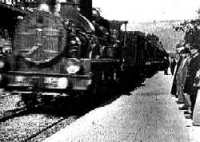Film theory
From The Art and Popular Culture Encyclopedia
| Revision as of 08:47, 4 June 2023 Jahsonic (Talk | contribs) ← Previous diff |
Revision as of 09:02, 4 June 2023 Jahsonic (Talk | contribs) Next diff → |
||
| Line 46: | Line 46: | ||
| * [[Walter Benjamin]] | * [[Walter Benjamin]] | ||
| * [[David Bordwell]] | * [[David Bordwell]] | ||
| - | * [[Riciotto Canudo]] | + | * [[Ricciotto Canudo]] |
| * [[Gilles Deleuze]] | * [[Gilles Deleuze]] | ||
| * [[Louis Delluc]] | * [[Louis Delluc]] | ||
Revision as of 09:02, 4 June 2023
|
"With the arrival of cinema, French philosopher Henri Bergson felt the need for new ways of thinking on movement and coined the terms "image-temps" and "image-mouvement" in Matière et Mémoire (1896). Gilles Deleuze, another French philosopher, took Matière et Mémoire as the basis of this theory on and used it to explain his views in his Cinéma I & II (1983-1985)." --Sholem Stein "The directors concerned are Jean Renoir, Robert Bresson, Jean Cocteau, Jacques Becker, Abel Gance, Max Ophuls, Jacques Tati, Roger Leenhardt; [...] it appears that these auteurs also write the dialogue to their films and invent the story lines of the films they direct (mettent en scène)." --"Une certaine tendance du cinéma français" (1954) by François Truffaut La Strada (1954), 8 1/2 (1963), Wild Strawberries (1957), The Seventh Seal (1957), Persona (1966), Ashes and Diamonds (1958), Jules et Jim (1962), Knife in the Water (1962), Vivre sa vie (1962), Muriel (1963): Whatever else one can say about these films, cultural fiat gives them a role altogether different from Rio Bravo (1959) on the one hand and Mothlight (1963) on the other. They are "art films," and, ignoring the tang of snobbishness about the phrase, we can say that these and many other films constitute a distinct branch of the cinematic institution."--"The Art Cinema as a Mode of Film Practice" (1979) by David Bordwell |

Illustration: screen shot from L'arrivée d'un train en gare de La Ciotat
|
Related e |
|
Featured: |
Film theory debates the essence of the cinema and provides conceptual frameworks for understanding film's relationship to reality, the other arts, individual viewers, and society at large. Film theory is generally distinguished from film criticism, which concentrates on evaluating individual films.
Contents |
History
In some respects, French philosopher Henri Bergson's Matter and Memory anticipated the development of film theory at a time that the cinema was just being born as a new medium—the early 1900s. He commented on the need for new ways of thinking about movement, and coined the terms "the movement-image" and "the time-image". However, in his 1906 essay L'illusion cinématographique (in L'évolution créatrice), he rejects film as an exemplification of what he had in mind. Nonetheless, decades later, in Cinéma I and Cinema II (1983-1985), the philosopher Gilles Deleuze took Matter and Memory as the basis of his philosophy of film and revisited Bergson's concepts, combining them with the semiotics of Charles Sanders Peirce.
Early film theory arose in the silent era and was mostly concerned with defining the crucial elements of the medium. It largely evolved from the works of directors like Germaine Dulac, Louis Delluc, Jean Epstein, Sergei Eisenstein, Lev Kuleshov, and Dziga Vertov and film theorists like Rudolf Arnheim, Béla Balázs and Siegfried Kracauer.
These individuals emphasized how film differed from reality and how it might be considered a valid art form.
In the years after World War II, the French film critic and theorist André Bazin reacted against this approach to the cinema, arguing that film's essence lay in its ability to mechanically reproduce reality, not in its difference from reality.
In the 1960s and 1970s, film theory took up residence in academe, importing concepts from established disciplines like psychoanalysis, gender studies, anthropology, literary theory, semiotics and linguistics.
During the 1990s the digital revolution in image technologies has had an impact on film theory in various ways. There has been a refocus onto celluloid film's ability to capture an indexical image of a moment in time by theorists like Mary Ann Doane, Philip Rosen and Laura Mulvey who was informed by psychoanalysis. From a psychoanalytical perspective, after the Lacanian notion of the Real, Slavoj Žižek offered new aspects of the gaze extensively used in contemporary film analysis. There has also been a historical revisiting of early cinema screenings, practices and spectatorship modes by writers Tom Gunning, Miriam Hansen and Yuri Tsivian.
Further reading
Specific theories of film
- Apparatus theory
- Auteur theory
- Feminist film theory
- Formalist film theory
- Marxist film theory
- Philosophy of language film analysis
- Psychoanalytical film theory
- Screen theory
- Structuralist film theory
List of film theorists
- Rudolf Arnheim
- Béla Balázs
- André Bazin
- Walter Benjamin
- David Bordwell
- Ricciotto Canudo
- Gilles Deleuze
- Louis Delluc
- Sergei Eisenstein
- Alexander Kluge
- Siegfried Kracauer
- Teresa de Lauretis
- Christian Metz
- Laura Mulvey
- Hugo Münsterberg
- Vivian Sobchack
- Slavoj Žižek
- Georg Lukacs
- Vsevolod Pudovkin
Specific theories of film
- Apparatus theory
- Auteur theory
- Feminist film theory
- Formalist film theory
- Marxist film theory
- Oneiric (film theory)
- Psychoanalytical film theory
- Socialist realism
- Screen theory
- Structuralist film theory
See also
- Auteur theory
- David Bordwell vs Slavoj Žižek
- Fictional film
- Film
- Philosophy of film
- Surrealism and film

